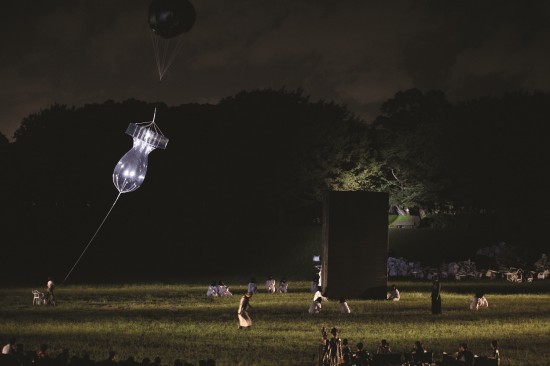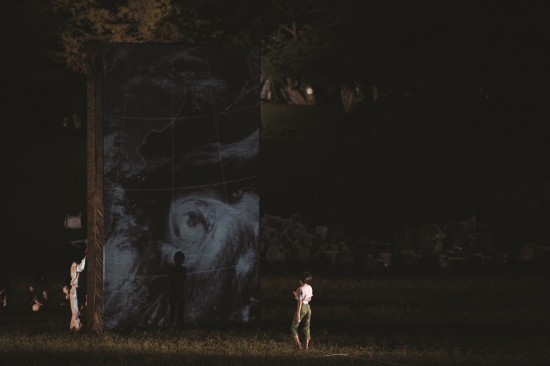A Restatement: The Art of ‘Ground Zero’ (Part 2)
ji me n (ground)
In his previous column, Noi Sawaragi introduced a reexamination of his concept of “the art of ground zero” by discussing the cultural resonance of the Daigo Fukuryu Maru, the Japanese fishing boat that was exposed to radioactive fallout during the United States’ Castle Bravo thermonuclear device test at Bikini Atoll in March 1954, and is now preserved in Yumenoshima Park in Tokyo.

All images: © Yota Kataoka
After viewing the performances of Norimizu Ameya and Romeo Castellucci at the Multipurpose Colosseum at Yumenoshima Park on the opening day of Festival/Tokyo 2011, I broke away from people hurriedly filing out of the venue in their eagerness to get home and set off on my own to explore the rest of the island. For me, this was the point where Norimizu Ameya’s ji me n (ground) really began.
I crossed the park and found myself on a wide pathway. It was a completely manmade, perfectly straight thoroughfare. And it was completely deserted. The only signs of life were the lamps shining on the pavement. It was as if the earlier experience of viewing the performances with all those other people was a dream. The dosimeter I carried indicated a reading of 0.14 microsieverts.
It was “there” that I came across the Daigo Fukuryu Maru Exhibition Hall. Naturally, since it was already past 9pm, the hall was closed, but I could still access the garden and walkway facing the water. There I found the engine from the Daigo Fukuryu Maru, which had been used as a motif in the performance I had just seen. It was my second visit to the Daigo Fukuryu Maru Exhibition Hall, but the first time I had had a good look around the outside of the building. A cherry tree had been planted nearby, and beside it was a memorial stone bearing the inscription, “Let us make the 21st century a century of peace.” No doubt when they were planting this cherry tree with the radiated Daigo Fukuryu Maru behind them, those involved prayed that this wish would come true. But their prayers were not answered. The 21st century has turned into the century of radioactivity. It was when I came across this inscription that I knew this was the first vista I had acquired from the evening’s performance.
Even when I stood on the water’s edge and looked into the distance, I could see nothing but the twinkling of harbor lights. Everything else was completely dark. And yet at the end of the performance an intense light had shone out in this direction. Like an insect drawn to a flame, before I knew what was happening I found myself walking in this same direction. I knew at the time that “there” stood the Daigo Fukuryu Maru Exhibition Hall. But it was only after an exchange with a follower on Twitter that I found out that if one extended a line across the sea in the direction in which the light shone it would eventually reach Bikini Atoll in the Marshall Islands, where the Daigo Fukuryu Maru had been exposed to radioactive fallout. (Author’s note: On checking with Ameya himself after the performance, I was able to confirm that there were several sources of light, but that Bikini Atoll did not necessarily lie on a line extended from any of them.)
The feeling I got was that the various carefully planned and presented devices, the acting of the innocent-looking children, the appearances by “distinguished people” such as the Emperor Showa and Madame Curie and so on, were nothing more than hints designed to assist each and every individual “here” at the performance to discover exactly “where” this place is. Precisely for this reason, the “end” of the performance had to signal the “beginning” of something more. For example, Yumenoshima is also the place – according to a scheme Taro Okamoto mapped out in the form of an urban design for a second Tokyo in the 1950s – where those disaffected with the existing capital would move, and clashing at a fundamental level with the old Tokyo, give rise to a whole new energy.
It is also the place where Kenzo Tange, a sworn friend and lifelong rival of Okamoto’s, planned his Marine City, which he imagined extending on both horizontal and vertical axes. Okamoto, on the other hand, had already astutely observed, “Yumenoshima is a zoo!” In opposition to Tange’s ultra-rationalism, Okamoto proposed “things outrageous” and utterly meaningless. It is possible to regard this confrontation as a precursor to the clash at Expo ’70 in Osaka between the Grand Roof (Tange) and the Tower of the Sun (Okamoto). If the spectacular Grand Roof produced by Tange at Expo ’70 is a summing up of Metabolism, the 1960s avant-garde urban design movement that his work came to symbolize, then Okamoto’s Tower of the Sun, which set out to spoil Tange’s roof by piercing an unsightly hole in it, was unmistakably an example of Anti-Metabolism. But actually the first skirmish in this battle between the two could be said to have broken out at Yumenoshima.
As soon as I got home I did some investigating. Ameya, who appeared as a cast member in his own performance, told the audience how his late father used to work for a power company, designing transmission towers. The person who advanced the idea of reclaiming Tokyo Bay was in fact Yasuzaemon Matsunaga, who immediately after the war was given the job of restructuring Japan’s power industry by setting up nine private power companies including the Tokyo Electric Power Company, or Tepco. Matsunaga was nicknamed the “king of electric power,” as well as the “devil of electric power,” but he was also widely known in the art world as a collector of antiquities. He was also famous for his dislike of officials, and caused a huge fuss during the war when he railed against a group of senior government officials who had been reduced to lackeys of the military clique, calling them “human trash.” At the end of the war, he defied officials who had mapped out a plan for collective control of the power industry and negotiated directly with GHQ, eventually gaining approval for his plan to divide up the state-controlled power company. (The result was the current regime, which is criticized for its regional monopolies, although there were scenarios that were even worse.) Anyway, given Ameya’s family history, it is difficult to imagine him not taking an interest in this “devil of electric power.” It is indeed a remarkable series of coincidences that the son of a man who designed transmission towers that once delivered electricity to people around the country should stage in the midst of a nuclear disaster an outdoor performance that touches on nuclear power at Yumenoshima, which had been reclaimed at the instigation of a man who had once dominated the power industry.
In any event, the land on Yumenoshima is reclaimed land. If one were to peel back just a single layer, like a child in a playground digging with a shovel, one would find buried there an incredible amount of garbage. Included among this there would undoubtedly be contaminants that would defy the imagination. In fact, the Daigo Fukuryu Maru itself was once dumped at Yumenoshima, like a massive piece of oversized trash. It was quite by accident that a city official discovered it during a visit to Yumenoshima and kicked off the preservation effort.
Well then, what does the “ground” of the title of Ameya’s performance actually mean? The first thing one notices in the Japanese title is the two spaces that have been intentionally opened between its three, constitutive phonetic characters, ji-me-n. As with Ameya’s 2005 exhibition “Va…..ng …nt,” the title of which featured the Japanese term for “vanishing point” with several characters removed to express the artist’s sense of loss at the collapse of the World Trade Center on 9/11 and at the death of his own father, and during which Ameya disappeared inside a box for the duration of the exhibition, it is highly likely that the spaces in this case also have some kind of meaning.
I discussed this with various people on Twitter, but despite our efforts we were unable to come up with any additional characters that might fill the gaps. Eventually it occurred to me that the gaps might represent not omissions but two “holes.” In his previous work, too, The shape of me (2010), Ameya dug a large hole in the grounds of an abandoned school. In other words, perhaps these gaps in the title are a symbolic act substituting with characters the manner in which the aboveground and underground are connected by means of the thin interface of the “ground.”

Come to think of it, during the performance of ji me n members of the cast often looked up at the sky. This night sky – in which bats flitted, and the moon rose directly above a sparkling Jupiter, and through which helicopters occasionally passed – was so calm one could hardly believe that just days later a typhoon would hit. Also, underneath this night sky was an “island” containing an untold amount of garbage. To pierce a hole in the “ground” that acts as an interface to link this sky with the earth; to dig a hole in the ground to unearth this garbage, linking directly this terra firma and the sky; to describe the amalgam of both in the form of what can only be called “ground”: most likely these were the aims of this performance. And didn’t the nuclear accident at Fukushima also involve the sky and earth being linked by radioactive material falling from the sky, as a result of which the “ground” became contaminated?
By a twist of fate, the night of the performance coincided with the opening of the exhibition “Metabolism: The City of the Future” at the Mori Art Museum. While this retrospective of Metabolism, the movement that once came up with “various designs” for artificial land, materialized on one vast floor of a high-rise building on another patch of artificial land, at Yumenoshima – the real main stage of Metabolism, which Okamoto once called a “zoo” – I sat on the bare earth and encountered a realm titled “ground.” Come to think of it, the most important work from the later part of Kenzo Tange’s career was the Tokyo Metropolitan Government Building, which, like Roppongi Hills, is a twin-towered high-rise building. In this sense, in Tokyo in the 21st century, Metabolism as a movement may have reached a different solution in the form of a jumble of high-rise buildings. However, real artificial land can still be found in the “ground” at Yumenoshima. And like Taro Okamoto, the artist born a century ago this year, who once produced a mural featuring the Daigo Fukuryu Maru in a depiction of the destruction wreaked by an atomic bomb, that ground is waiting for the “myth of tomorrow” to unfold, while the “myth of tomorrow” that persists in spite of nuclear war (ie, nuclear accidents) now takes the form of humankind’s new “colosseum.”
